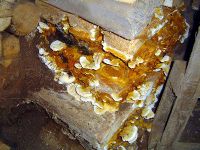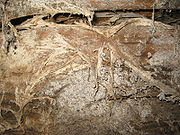
Serpula lacrymans
Encyclopedia


Dry rot
Dry rot refers to a type of wood decay caused by certain types of fungi, also known as True Dry Rot, that digests parts of the wood which give the wood strength and stiffness...
. It is a basidiomycete in the order Boletales
Boletales
The Boletales are an order of Agaricomycetes, containing over 1300 species with a diverse array of fruiting body types. The boletes are the best known members of this group, and until recently, the Boletales were thought to only contain boletes...
.
Taxonomy
The species was first describedSpecies description
A species description or type description is a formal description of a newly discovered species, usually in the form of a scientific paper. Its purpose is to give a clear description of a new species of organism and explain how it differs from species which have been described previously, or are...
under the name Boletus lacrymans by Franz Xavier von Wulfen in 1781. It was transferred to the genus Serpula
Serpula (fungus)
Serpula is a genus of fungi in the Serpulaceae family. According to the Dictionary of the Fungi , the family contains two species, although the taxonomical database Index Fungorum indicates three valid species: S. himantioides, S. lacrymans, and S. tignicola....
by Petter Karsten in 1884.
The specific epithet is derived from the Latin
Latin
Latin is an Italic language originally spoken in Latium and Ancient Rome. It, along with most European languages, is a descendant of the ancient Proto-Indo-European language. Although it is considered a dead language, a number of scholars and members of the Christian clergy speak it fluently, and...
words serpula for "creeping" (as in a serpent) and lacrymans, meaning "tears".
Environment
Serpula lacrymans has a preference for temperatures of 21 Celsius but can survive any temperature from 3 Celsius. It is not clear how much light is needed to promote Serpula lacrymans growth. In terms of aeration Serpula lacrymans often grows near ventilation shafts which shows a preference for concentrated oxygen. A moisture content of 30 to 40 percent is its ideal level in wood to promote fruit body formation. It appears that Serpula lacrymans requires an environment where both inorganic and organic materials are present. The fungus uses calciumCalcium
Calcium is the chemical element with the symbol Ca and atomic number 20. It has an atomic mass of 40.078 amu. Calcium is a soft gray alkaline earth metal, and is the fifth-most-abundant element by mass in the Earth's crust...
and iron ion
Ion
An ion is an atom or molecule in which the total number of electrons is not equal to the total number of protons, giving it a net positive or negative electrical charge. The name was given by physicist Michael Faraday for the substances that allow a current to pass between electrodes in a...
s extracted from plaster
Plaster
Plaster is a building material used for coating walls and ceilings. Plaster starts as a dry powder similar to mortar or cement and like those materials it is mixed with water to form a paste which liberates heat and then hardens. Unlike mortar and cement, plaster remains quite soft after setting,...
, brick
Brick
A brick is a block of ceramic material used in masonry construction, usually laid using various kinds of mortar. It has been regarded as one of the longest lasting and strongest building materials used throughout history.-History:...
, and stone to aid the break-down of wood, which results in brown rot.
Distribution
Although it is a common indoor biodeterioration agent, it has only been found in a few natural environments, the HimalayasHimalayas
The Himalaya Range or Himalaya Mountains Sanskrit: Devanagari: हिमालय, literally "abode of snow"), usually called the Himalayas or Himalaya for short, is a mountain range in Asia, separating the Indian subcontinent from the Tibetan Plateau...
, Northern California
Northern California
Northern California is the northern portion of the U.S. state of California. The San Francisco Bay Area , and Sacramento as well as its metropolitan area are the main population centers...
, the Czech Republic
Czech Republic
The Czech Republic is a landlocked country in Central Europe. The country is bordered by Poland to the northeast, Slovakia to the east, Austria to the south, and Germany to the west and northwest....
and east Asia. A recent study on the evolutionary origin and spread of this species using genetic markers (amplified fragment length polymorphism
Amplified fragment length polymorphism
Amplified Fragment Length Polymorphism PCR is a PCR-based tool used in genetics research, DNA fingerprinting, and in the practice of genetic engineering. Developed in the early 1990s by Keygene, AFLP uses restriction enzymes to digest genomic DNA, followed by ligation of adaptors to the sticky...
s, DNA sequences and microsatellites) on a worldwide sample of specimens suggested the existence of two main lineages, a nonaggressive lineage found in North America, and an aggressive lineage found on all continents, both in natural environments and buildings.
Impact on structures
Serpula lacrymans is considered to be the most damaging destroyer of indoor wood construction materials in temperateTemperate
In geography, temperate or tepid latitudes of the globe lie between the tropics and the polar circles. The changes in these regions between summer and winter are generally relatively moderate, rather than extreme hot or cold...
regions.
"In the United Kingdom alone, the estimated cost of rectifying damage caused by dry rot is at least 150 million pounds per annum."

